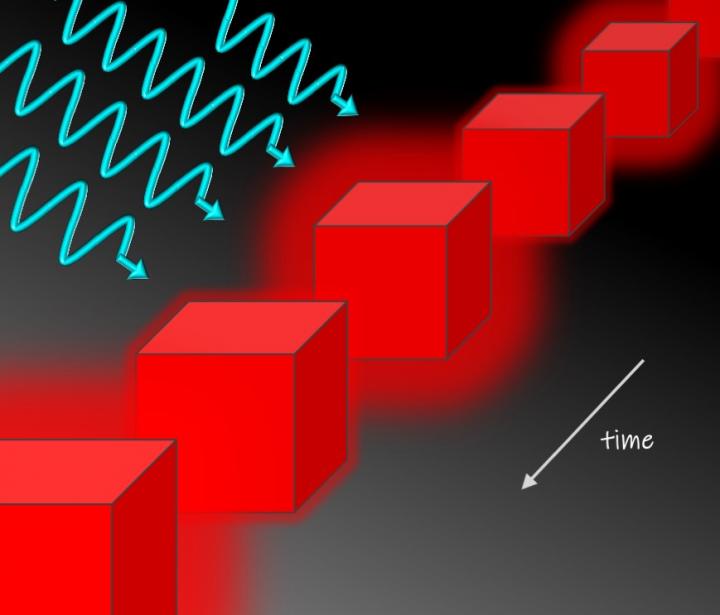Time for a new state of matter in high-temperature superconductors

Scientists from Universität Hamburg propose to create a time crystal out of a high-temperature superconductor by shining light on it. This creates macroscopic oscillations of the Higgs field.
Credit: UHH/Mathey
When you cool down liquid water, it crystallizes into ice. Consider a bucket filled with water, for example. When the water is liquid, the water molecules can be anywhere inside the bucket. In this sense, every point inside the bucket is equivalent. Once the water freezes, however, the water molecules occupy well-defined positions in space.
Thus, not every point inside the bucket is equivalent anymore. Physicists refer to this phenomenon as spontaneous symmetry breaking. Here the translation symmetry in space is broken by the formation of the crystal.
Is it possible for crystals to form in time instead of space? While it appears like an outlandish notion, it turns out that a time crystal may emerge when a physical system of many interacting particles is periodically driven. The defining feature of a time crystal is that a macroscopic observable, such as the electric current in a solid, oscillates at a frequency that is smaller than the driving frequency.
So far, time crystals have been realized in artificial model systems. But now, what about real systems? A piece of a high-temperature superconductor is such a real system – you can buy it online. It is not much to look at, with its brownish, rusty color. Yet its frictionless electron flow at temperatures up to 100 K ( 173 °C) constitutes one of the most spectacular phenomena of material science.
“We propose to turn a high-temperature superconductor into a time crystal by shining a laser on it”, explains first author Guido Homann from the Department of Physics at Universität Hamburg. The frequency of the laser needs to be tuned to the sum resonance of two fundamental excitations of the material. One of these excitations is the elusive Higgs mode, which is conceptually related to the Higgs boson in particle physics. The other excitation is the plasma mode, corresponding to an oscillatory motion of electron pairs, which are responsible for superconductivity.
Co-author Dr. Jayson Cosme from Universität Hamburg, now University of the Philippines, adds that “the creation of a time crystal in a high-temperature superconductor is an important step because it establishes this genuine dynamical phase of matter in the domain of solid-state physics”. Controlling solids by light is not only fascinating from a scientific perspective but also technologically relevant, as emphasized by group leader Prof. Dr. Ludwig Mathey.
“The ultimate goal of our research is to design quantum materials on demand.” With their novel proposal, this fascinating endeavor is now advanced towards dynamical states of matter, rather than the usual static states of matter, by laying out a strategy to design time crystals instead of regular crystals, which opens up a new and surprising direction of material design.
###
Publication:
Guido Homann, Jayson G. Cosme, and Ludwig Mathey (2020): Higgs time crystal in a high-Tc superconductor. Phys. Rev. Research 2, 043214 – Published 10 November. DOI: https:/
All latest news from the category: Physics and Astronomy
This area deals with the fundamental laws and building blocks of nature and how they interact, the properties and the behavior of matter, and research into space and time and their structures.
innovations-report provides in-depth reports and articles on subjects such as astrophysics, laser technologies, nuclear, quantum, particle and solid-state physics, nanotechnologies, planetary research and findings (Mars, Venus) and developments related to the Hubble Telescope.
Newest articles

A universal framework for spatial biology
SpatialData is a freely accessible tool to unify and integrate data from different omics technologies accounting for spatial information, which can provide holistic insights into health and disease. Biological processes…

How complex biological processes arise
A $20 million grant from the U.S. National Science Foundation (NSF) will support the establishment and operation of the National Synthesis Center for Emergence in the Molecular and Cellular Sciences (NCEMS) at…

Airborne single-photon lidar system achieves high-resolution 3D imaging
Compact, low-power system opens doors for photon-efficient drone and satellite-based environmental monitoring and mapping. Researchers have developed a compact and lightweight single-photon airborne lidar system that can acquire high-resolution 3D…





















